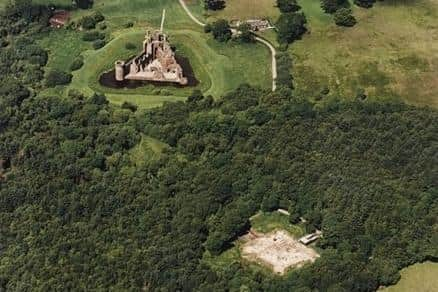Sustainable Scotland: Ancient castles were hit by medieval climate change, researchers find
New analysis shows how the original Caerlaverock Castle, built in the 1220s, and its replacement, erected around 1277, were both affected by the impacts of extreme weather that took place during a period of climate change between 1200 and 1570.
Researchers who examined the 800-year-old site, near Dumfries, have also concluded that an area at the older castle was not, as had previously been thought, a harbour.
Advertisement
Hide AdAdvertisement
Hide AdStudies were led by Dr Richard Tipping and Dr Eileen Tisdall, environmental scientists at the University of Stirling, with funding from the Castle Studies Trust and national caretaking body Historic Environment Scotland (HES), which is in charge of the ruinous Caerlaverock castle and the remains of its nearby predecessor.
Evidence uncovered at the site reveals tidal surges hit the area between 200BC and 200AD and then again between around 1200 to 1570, with frequent incidents where stormy waters rose 9m above usual sea level.
It had been thought the inhabitants of the first castle moved to the new site, 200m further inland and on higher ground than the original, to avoid those medieval storms.
However, the new castle is situated only 7m above sea level, so was also impacted by the medieval storms.


The team concluded that the waves were not powerful enough to undermine the structure of the old castle, so there were questions why the owners had moved only such a short distance away.
Now it’s believed the new site was the highest point that would still allow access to the natural springs needed to supply a wet moat around the new stronghold.
The original castle was similar to a moated manor house, which was later fortified with the addition of a stone curtain wall and eventually corner towers.
The new castle was built on a similar theme but to a much grander design and with a unique triangular shape.
Advertisement
Hide AdAdvertisement
Hide AdCore samples of the moat revealed sediments dating back 6,000 years, formed when the so-called harbour was a tidal creek.
Analysis shows the creek was widened and possibly deepened around 1200, but even so, waves during the highest ordinary tides could not have flooded it.
But it was the only way that freshwater in the moat system could drain to the sea.
It was also the quickest route for storm surges, increasing in frequency if not scale, to force their way inland.
But they didn’t. Harbour sediments from around 1200 point to still-water, low-energy deposition, suggesting the ‘harbour’ entrance may have been blocked off by people increasingly scared of the changing climate.
Dr Morvern French, properties historian at HES, said: “Using new techniques and analyses that were not available 20 years ago, the project team has shed new light on the environment of this strategically and architecturally significant castle.
“The research shows that coastal climate change significantly affected people’s lives in Scotland’s past, as it continues to shape both our present and future.
“Historic sites like Caerlaverock offer a unique perspective on how humans have adapted to changes in the environment over hundreds of years, and we now know more about the lived experience of these inhabitants during an era which was turbulent not only militarily but also climatically.
Advertisement
Hide AdAdvertisement
Hide Ad“We look forward to incorporating this research into our visitor-facing interpretation so we can continue to tell Scotland’s climate story and provide a way for our visitors to connect with those who lived here hundreds of years ago, who would have faced the impacts of the changing climate much like we do today.”
Caerlaverock Castle is currently off-limits to visitors for safety reasons, to allow high-level masonry inspections that will assess how weathering is affecting the structure.
However, the grounds, including the remains of the old castle, are open.
Comments
Want to join the conversation? Please or to comment on this article.
